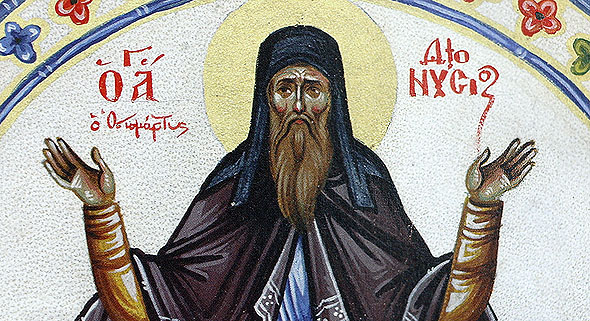The Blessed Martyrs Neofytos, Amvrosios and Makarios († 1821) and Dionysios († 1822)
23 June 2014These were monks of the holy monastery of Vatopaidi. In 1820, the hieromonks Neofytos and Amvrosios, the hierodeacon Parthenios and the monks Dionysios and Dorotheos were sent to Crete, where they were later joined by Makarios, having been invited to take sacred relics there in order to rid the area of the dreadful plague which was devastating the inhabitants of the island. The relics were a portion of the Precious Girdle of the Mother of God, a gift to the monastery from Emperor Ioannis Kantakouzinos, a piece of the Precious Cross, and the skull of Saint Andrew of Crete.
From the narrative of the monk Arsenios Pantokratorinos, which was copied on 25 June1932, and is preserved in the monastery of Vatopaidi, we learn that the monastery sent five of its brothers, together with the precious relics mentioned above, to Irakleio, the Megalo Kastro (Great Castle) [the city’s name under the Turks] in June 1820. After a fortnight’s voyage, the fathers of Vatopaidi arrived at Irakleio and, after an official welcome there, they performed blessing services until Easter in 1821.
On 22 June 1821, the clergy and laity were gathered in the metropolis of Irakleio, for fear of the Turks, since there’d been uprisings in a number of places. When the Turks entered the building of the metropolis, they put to death both clergy and laity, among whom were the Vatopaidan hieromonks Neofytos and Amvrosios and the monk Makarios. The hierodeacon Parthenios and the monks Dionysios and Dorotheos took the Holy Girdle, the Precious Cross and the skull of Saint Andrew of Crete and hid in the houses of crypto-Christians.
After being hounded for some time, Monk Dionysios was arrested, ‘they tried to force him to convert to Islam but he resisted’. After he’d been tortured horribly, they pierced his head with a red-hot spit and hanged him on the first Monday of Lent in 1822. He had earlier had confession and had received the divine and spotless sacraments. A letter dated 2/9/1824, from the hierodeacon Parthenios, who survived, confirms that one of the fathers, clearly Dionysios, was, indeed, hanged.
His precious relics were passed on among the faithful and eventually reached Santorini, where, after a great many efforts, Pro-Abbot Dionysios of Vatopaidi, with the assistance of the local metropolitan Zakharias, managed to catch up with them and bring them back to the monastery on 2/5/1831.

Patriarchal Act of Ecumenical Patriarch Bartholomew on the canonization of the blessed martyr Dionysios, 11/4/2000
The Great Church of Christ, the Ecumenical Patriarchate, by the Patriarchal and Synodal Act no. 837 of 21/9/2000, entered the above Vatopaidan fathers in the register of saints of the Orthodox Church, together with other martyrs in Crete, ‘because they publicly accepted martyrdom for Christ and confessed Jesus Christ before all, shedding their blood for the sake of the true confession and of martyrdom, as genuine martyrs of Christ, being martyred before all the Orthodox Christians in the great island of Crete’.
At the point in their service where they are remembered, it says that bishops and clergy were murdered, ‘as well as Athonite fathers from the Holy Monastery of Vatopaidi who had brought to the Great Castle precious relics and the holy girdle of the Mother of God, to be venerated at the time of the epidemic of the plague’.
The Blessed Martyr Dionysios is commemorated on 31 July and 10 October. His fellow martyrs Neofytos, Amvrosios and Makarios are honoured on 22 July.








